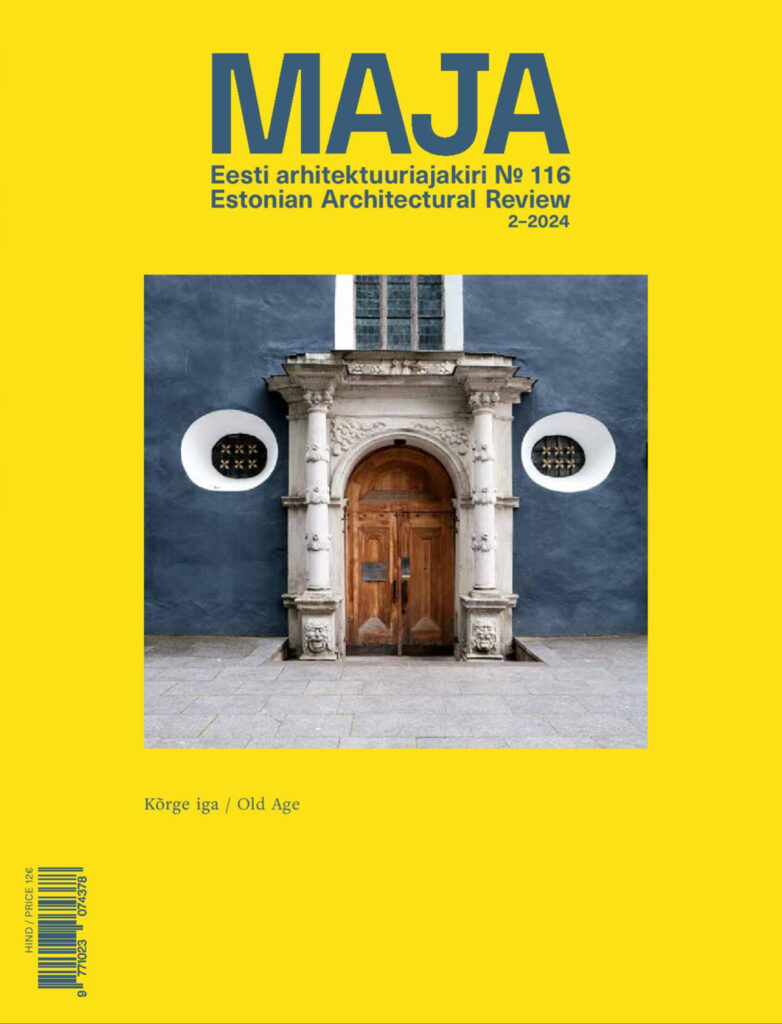OUTSET
A Rolling Stone Gathers No Moss
Sirle Salmistu
PROJECT
Kasugadai Center Centre
Aikawa, Japan / teco
Yuma Shinohara
OBJECTION
On Self-Checkouts
AImar Altosaar
ESSAY
My Old Man
Mae Köömnemägi, Siim Vahur
ESSAY
Side Effects of the Renovation Wave
Lauri Lihtmaa
LETTER
He—the Woodpecker—Is A Real Estate Developer
Malle Jürgenson
RESEARCH
Making Home in Old Age
Jakob D’herde
CASE STUDY
Later Living Here and There
Laura Linsi
PROJECT
Mustjala Care Home and Day Centre
Saaremaa / molumba
Inke-Brett Eek
ESSAY
How Well Cn We Access Culture?
Grete Tiigiste
PROJECT
Niguliste Museum Lift
Tallinn / KOKO
Jaak Huimerind
ESSAY
‘The Real Answer Will Be Given by History’
Ingrid Ruudi
PROFILE
Rein Einasto
Laura Linsi
FRAGMENTS
Pension Pillars
Madli Kaljuste
OLD AGE
Our present society has been shaped for adults at the peak of their abilities, but when it comes to normal age-related changes, the environment is indifferent and unforthcoming—so says MTÜ Kuldne Liiga [NPO Golden League] in its report ‘Age-Friendly Estonia’. In a similar vein, Sirle Salmistu writes that there is a stereotype about older people needing help. Aging is indeed accompanied by changes in functional and cognitive abilities, and yet, people whose age varies in the range of forty years cannot be measured against each other, just as we do not compare a one-year-old to a 30-year-old. The elderly also cannot be considered a marginal part of the society—it is estimated that by 2045, 27% of the population of Estonia will be older than 65. In what ways should architects account for our ageing society?
In organising our society as well as in designing our spaces, we should aim for creating welfare rather than simply solving problems. In an age-friendly city, older people can feel secure and comfortable (i.e., feel that they are able to go there in the first place), but also engaged. Jaak Huimerind writes about the lift in Niguliste Museum, which enables mobility-restricted visitors of the church to be equal among others. And yet, the issue is not merely about public space. As Grete Tiigiste notes, every museum visit begins at home. Both in a 5-storey apartment block without a lift and a Tsarist-era building where there is no consensus to renovate, a resident whose cognitive and physical abilities are on the decline might end up trapped in a dwelling that has for many years been their home. Jakob D’herde writes that homemaking is a constant negotiation process between a physical dwelling and a person’s imaginary of a home—a process that should not cease in old age. In this spirit, a group of English women formed the Older Women’s Co-Housing Group and initiated the development of their age-friendly homes themselves. In Mustjala village on the island of Saaremaa, the municipality took the lead by combining a care home and a day centre, which is reviewed by Inke-Brett Eek.
Most people are more or less consciously preparing for old age, the most ordinary and nationally approved preparation consisting in accumulating money into pension funds. Are we opening Pandora’s box when we ask how and if these most common investment funds affect environmental and social developments now and in the near future?
Laura Linsi, Editor-in-chief
Madli Kaljuste, Editor
June, 2024





